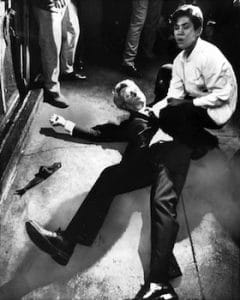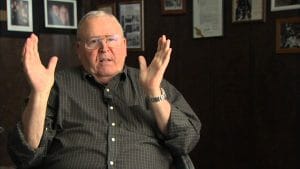A photographer, Yaro had a part-time job with the Los Angeles Times, Yaro had gone home not feeling well, but Pepto Bismol perked him up, so he grabbed his camera and headed out. Robert F. Kennedy had just won the California Primary for nomination as the Democratic candidate for President of the United States, and Yaro, still off duty, went to the Ambassador Hotel hoping to get a photo of Kennedy — for his own wall. Yaro came into the ballroom via a service entrance and ran into Kennedy, but he didn’t have a flash for his camera and didn’t take any photos. After the candidate made his acceptance speech, Yaro went back to the service entrance, thinking Kennedy would go back out that way. He did, but when Kennedy got about 3 feet from him, Yaro heard “firecrackers” — and was hit in the face with debris. As the crowd parted, he could see Sirhan Sirhan emptying an 8-shot .22 caliber pistol toward Kennedy, who was hit three times (five others were wounded). Several men jumped Sirhan, knocking the pistol from his hand. When he saw Sirhan trying to get the revolver, Yaro grabbed it. “I turned away from the scuffle and was thinking, ‘It’s warm. The gun is warm,’” Yaro remembered, “and all of a sudden it was taken from me. I didn’t see who grabbed it, but I saw the back end of a sport coat and figured it might be a cop.” As his mind cleared, he saw “RFK was slowly sinking to the floor, and I realized I had better make pictures. I used my Nikon FTn and a 28mm lens. At the time, a woman grabbed my coat sleeve and began tugging all the while shouting, ‘Don’t take pictures!” I pulled my arm back, freeing myself from her grasp and yelled, “Goddammit lady, this is history!” In all, he only took six photos.

Yaro ran for a phone, but when he couldn’t get a line he ran toward his car. Spotting a payphone on the street, he called the city desk and said just three words: “I have photos.” City Editor Bill Thomas “yelled ‘Get ’em down here!’” — Yaro knew they’d hold the presses to get his photos in. When he arrived a tech was waiting to develop Yaro’s film, and he told the tech to double the development time because “the lighting was terrible.” Sure enough, “it did the job, and we had printable images, albeit somewhat contrasty.” Yaro sat down with a reporter to dictate what he had witnessed, and then “I took a quick look at the photos and the whole incident began to take over my feelings,” he said. “I went back into my darkroom. And I wept.” Yaro’s main photo is iconic, showing Kennedy being cradled by busboy Juan Romero, who wanted to ensure Kennedy’s head didn’t touch the ground; he was still conscious. Kennedy asked Romero, “Is everybody safe — OK?” Romero replied, “Yes, yes, everything is going to be OK.” Kennedy, 42, died the next day. Sirhan, a Palestinian born a Christian in Jerusalem, pleaded guilty in exchange for a life sentence, rather than execution; he is still alive at 75, and housed in a California prison. The assassination is considered the first major incident of political violence in the United States stemming from the Arab-Israeli conflict in the Middle East.

Yaro’s photo is in the permanent collections of the Getty Museum, and New York’s Museum of Modern Art. Yaro was quickly hired full-time at the Times and worked there for more than 40 years. When the Lou Grant TV show (1977–1982) was gearing up for production, the show’s news photographer, “Animal,” was played by Daryl Anderson. The actor studied with Yaro so he could depict the best of the best of newspaper photographers. Yaro, however, was no “animal” — he always wore a blazer and a tie on the job. “You can’t walk into a newsroom dressed as a damn bum,” he said. After his experience in 1968, he was pretty much always on duty, keeping police scanners on in his car, and even his bedroom. “He never left home without some form of connected communication,” said his daughter, Nicole Good. “He always had one, maybe two, maybe three cameras with him, film in every single pocket.” Yaro died at his home in Northridge, Calif., on March 11. He was 81.
